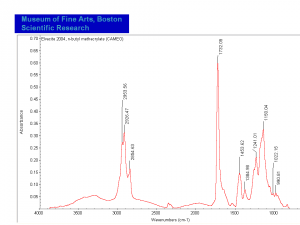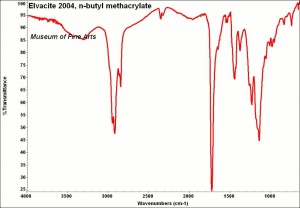Difference between revisions of "Elvacite"
Jump to navigation
Jump to search
| (2 intermediate revisions by the same user not shown) | |||
| Line 1: | Line 1: | ||
== Description == | == Description == | ||
| − | + | [[[SliderGallery rightalign|Elvacite 2004 FTIR.PNG~FTIR|Elvacite2004IR.jpg~FTIR]]] | |
[Lucite International] A registered trademark for a series of polymers composed of ethyl or butyl methacrylate resins. Previously called Lucite® resins, these acrylics were tried as picture varnishes in the 1930s and 40s because they were resistant to yellowing. However subsequent testing has shown that the butyl methacrylates crosslink when exposed to light and become 50% insoluble after 22 years (Feller, 1971). Additionally Elvacite® 2044 has a low glass transition point, which makes it soft and susceptible to dirt collection. | [Lucite International] A registered trademark for a series of polymers composed of ethyl or butyl methacrylate resins. Previously called Lucite® resins, these acrylics were tried as picture varnishes in the 1930s and 40s because they were resistant to yellowing. However subsequent testing has shown that the butyl methacrylates crosslink when exposed to light and become 50% insoluble after 22 years (Feller, 1971). Additionally Elvacite® 2044 has a low glass transition point, which makes it soft and susceptible to dirt collection. | ||
| − | + | * Elvacite® 2043 - ethyl methacrylate; Tg = 65C. | |
| − | + | * Elvacite® 2044 - n-butyl methacrylate; Tg = 20C. | |
| − | + | * Elvacite® 2045 - isobutyl methacrylate; Tg = 50C. | |
| − | + | * Elvacite® 2046 - a 1:1 mixture of 2044 and 2045; Tg = 35C. | |
| − | + | * Elvacite® 2013 | |
| − | + | * Elvacite® 2028 | |
| − | |||
| − | |||
| − | |||
| − | |||
| − | |||
== Synonyms and Related Terms == | == Synonyms and Related Terms == | ||
| Line 19: | Line 14: | ||
Lucite® resin [DuPont] | Lucite® resin [DuPont] | ||
| − | + | ==Physical and Chemical Properties== | |
| − | |||
| − | == | ||
| − | |||
| − | |||
| − | |||
| − | |||
| − | |||
| − | |||
| − | |||
| − | |||
| − | = | + | * Soluble in turpentine, ligroin, toluene. |
| + | * Refractive Index = 1.483 | ||
| − | + | ==Resources and Citations== | |
| − | + | * ChemPoint: [https://www.chempoint.com/products/mitsubishi-chemical-america/elvacite-specialty-acrylic-resins Elvacite resins] | |
| − | + | * J. Down, M.MacDonald, J.Te'treault, S.Williams, Adhesive Testing at the Canadian Conservation Institute-An Evaluation of Selected Poly(Vinyl acetate) and Acrylic Adhesives", ''Studies in Conservation'' 41:19-44, 1996. | |
| − | |||
| − | * | ||
* C.V.Horie, ''Materials for Conservation'', Butterworth-Heineman, London, 1997 | * C.V.Horie, ''Materials for Conservation'', Butterworth-Heineman, London, 1997 | ||
| Line 49: | Line 33: | ||
* Cricket Harbeck, Adhesives Commonly used in Objects Conservation, unpublished, 1996 | * Cricket Harbeck, Adhesives Commonly used in Objects Conservation, unpublished, 1996 | ||
| − | + | * Lookpolymers: [http://www.lookpolymers.com/tradename_Elvacite-.php Elvacite info] | |
[[Category:Materials database]] | [[Category:Materials database]] | ||
Latest revision as of 14:49, 1 August 2022
Description
[Lucite International] A registered trademark for a series of polymers composed of ethyl or butyl methacrylate resins. Previously called Lucite® resins, these acrylics were tried as picture varnishes in the 1930s and 40s because they were resistant to yellowing. However subsequent testing has shown that the butyl methacrylates crosslink when exposed to light and become 50% insoluble after 22 years (Feller, 1971). Additionally Elvacite® 2044 has a low glass transition point, which makes it soft and susceptible to dirt collection.
- Elvacite® 2043 - ethyl methacrylate; Tg = 65C.
- Elvacite® 2044 - n-butyl methacrylate; Tg = 20C.
- Elvacite® 2045 - isobutyl methacrylate; Tg = 50C.
- Elvacite® 2046 - a 1:1 mixture of 2044 and 2045; Tg = 35C.
- Elvacite® 2013
- Elvacite® 2028
Synonyms and Related Terms
Lucite® resin [DuPont]
Physical and Chemical Properties
- Soluble in turpentine, ligroin, toluene.
- Refractive Index = 1.483
Resources and Citations
- ChemPoint: Elvacite resins
- J. Down, M.MacDonald, J.Te'treault, S.Williams, Adhesive Testing at the Canadian Conservation Institute-An Evaluation of Selected Poly(Vinyl acetate) and Acrylic Adhesives", Studies in Conservation 41:19-44, 1996.
- C.V.Horie, Materials for Conservation, Butterworth-Heineman, London, 1997
- Marie Svoboda, Conservation Survey Index, unpublished, 1997
- Teri Hensick, contributed information, 1998
- Cricket Harbeck, Adhesives Commonly used in Objects Conservation, unpublished, 1996
- Lookpolymers: Elvacite info

